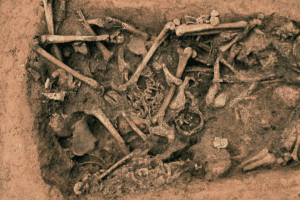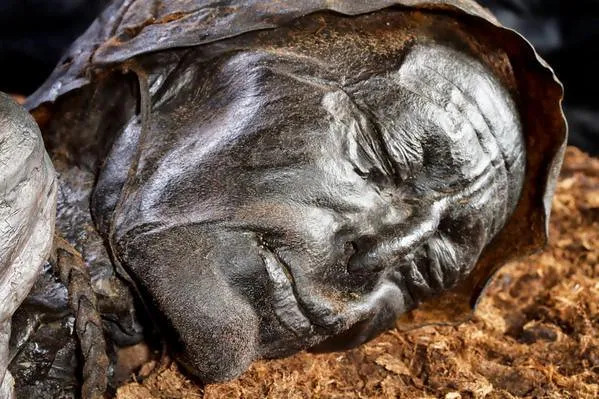
With Tollund Man, his eyes are closed as if in sleep, his lips opened as if about to speak. The stubble on his chin looks fresh, like it had grown just days ago. But this man has been dead for over 2,000 years—and someone had murdered him.
On May 6, 1950, two brothers were cutting peat in Bjældskovdal, a remote bog in Denmark’s Jutland Peninsula, when their shovels struck something soft. Something was wrong. Viggo Højgaard’s blade had hit what felt like leather, but when he scraped away the dark peat, a human face stared back at him—eyes closed, skin intact, looking for all the world like a man who had drowned just days before.
The brothers stumbled backwards in horror. Their first instinct was to call the police—surely this was a recent murder, a body dumped in the isolated bog. The victim’s stubble was visible, his skin supple to the touch. But what they had mistaken for fresh death was actually one of history’s most perfectly preserved ancient corpses. This man had met his end in the most terrifying way imaginable over two millennia ago.

The Horror Beneath the Peat – Tollund Man
The Tollund Man’s preservation is so eerily perfect that it defies comprehension. His skin, bronze-tinted by the bog’s tannins, remains supple and intact. His fingerprints are still visible. His hair—a reddish-brown crop cut short—looks freshly trimmed. Most unnerving of all is his face: peaceful, almost meditative, with closed eyes and a slight frown that could perhaps suggest he was deep in thought during his final moments.
A Violent Death, But A Peaceful Face?
This is the contradiction that haunts everyone who sees him. Here is a man who died horribly—strangled, murdered, his life snuffed out—yet his expression is that of someone drifting off to sleep. There’s no terror etched into his features, no final scream frozen on his lips. Instead, he looks contemplative, resigned, perhaps even willing? It’s a paradox that chills the soul: violent death wearing the mask of serenity. The two things do not naturally go together, but with Tollund Man, we can see two sides of the same coin.
Circle around to view his neck, and the horror reveals itself in all its methodical brutality.
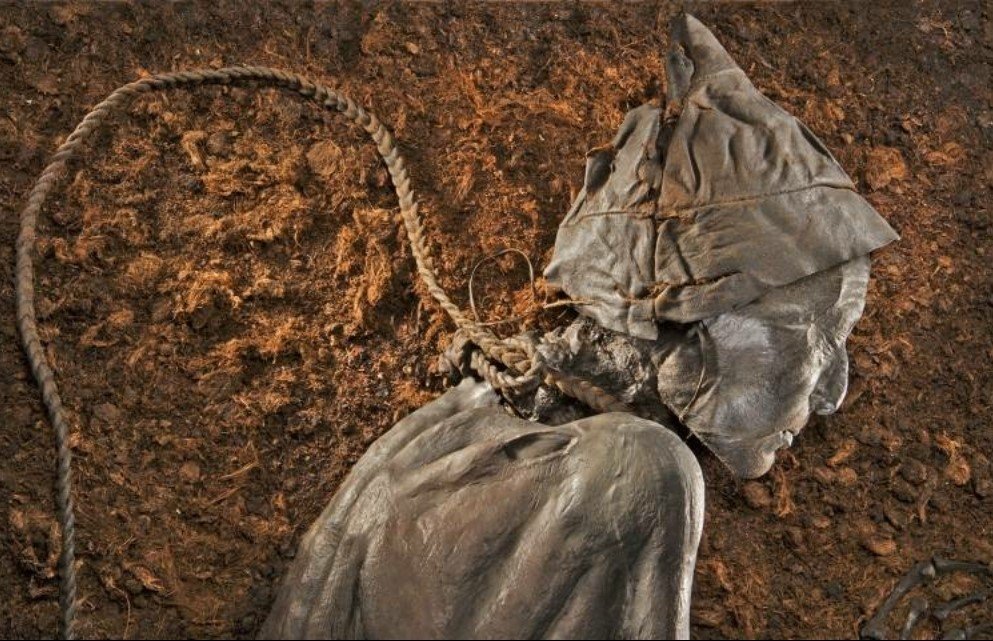
A Cold, Methodical Killing
A braided leather rope, woven with meticulous care, remains exactly where his killer placed it over two thousand years ago. Here, time stands still for a moment. The noose is still pulled tight, the knot positioned precisely behind his left ear with professional efficiency. This wasn’t a crime of passion or a hasty execution—it was methodical, ritualistic, deliberate. This rope is prepared neatly braided for a purpose.
More Horrifying Than Fictional Nightmares
The juxtaposition is deeply unsettling: a face that appears peaceful coupled with evidence of calculated murder. What kind of society creates such a contradiction? What beliefs could make a man face his own strangulation with such apparent calm? The Tollund Man forces us to confront the terrifying possibility that he may have went willingly to his death—and that somehow makes his story more horrifying than any fictional nightmare.
No horror movie could conjure something this disturbing because no screenwriter would dare suggest that victims might embrace their own murders. Yet here lies potential evidence, preserved in bog water and time: a man who appears to have found peace in his final moments of being strangled. It’s a horror that cuts deeper than any invented monster because it’s absolutely, unnervingly absolute, and it is real.
A Death Frozen in Time
Radiocarbon dating placed the Tollund Man’s death between 405 and 380 BCE, during Denmark’s Pre-Roman Iron Age. This was a time of Celtic influence, when druids wielded power and human sacrifice wasn’t just accepted—it was a sacred duty.
The bog had acted as nature’s perfect mortician, its acidic, oxygen-free environment essentially mummifying him for 2,400 years.
But who was he? And why did he have to die?
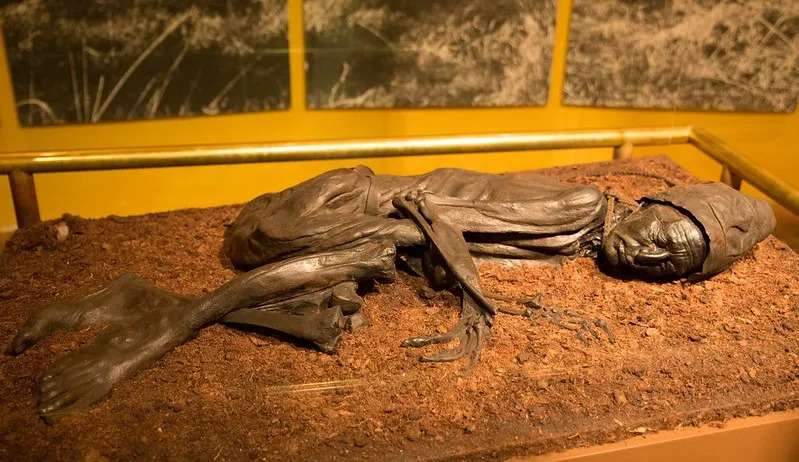
The Burning Question: Who Was He?
Perhaps most chilling is the possibility that he simply accepted his fate and walked willingly to his death. In a world where being chosen for sacrifice might have been considered the highest honour—or the most terrible duty—did he trudge through the marshland knowing he would never return? How did he feel at that very moment knowing his time was up?
How Did He Get Through This – Drugs?
Did he see his death as noble service to his community, or did he go with quiet resignation to a fate he couldn’t escape?
The serenity in his face raises haunting questions: Was he drugged with ergot or other hallucinogenic plants known to Iron Age peoples, drifting into death in a chemically-induced trance? The bog’s acidic environment may have destroyed all traces of such substances, or perhaps our modern methods simply can’t detect compounds used 2,400 years ago.
Not Knowing Is Haunting To Many
But the absence of evidence proves nothing—and that uncertainty is perhaps the most chilling aspect of all. We’re left suspended between equally disturbing possibilities: a man drugged into compliant death, or someone who faced his own strangulation with full awareness and inexplicable calm. Both scenarios are horrifying in different ways, and we may never know which one is real.
The Victim’s Last “Meal” – A Modern Crime Scene Investigation
Scientists have reconstructed Tollund Man’s final hours with forensic precision, a process that reads like a modern crime scene investigation. But what they discovered in his stomach was no ordinary breakfast.
Like any man on death row, he was offered his last meal.
His last meal consisted of a thin gruel made from barley, linseed, and dozens of wild seeds—including threshing waste that could relate to ritual practices. Eating plants and seeds that do not usually go together, and consuming plant waste, is partly ritualistic but could also signify a form of humiliation. This wasn’t the hearty meal you’d give a condemned criminal before execution. The ingredients included plants that wouldn’t naturally grow together, indicating this mixture was specially prepared—and for a deeply sinister purpose.
More Chilling Discoveries
Similar gruel has been found in the digestive tracts of other bog body victims, suggesting this was a standardised ritual meal. Even more chilling, some scholars believe ergot may have been included in these ritual drinks, similar to those used in prehistoric fertility cults. The very fact that ergot sclerotiums were found in another bog body, the Grauballe Man, suggests this practice was deliberate. However, it is not scientifically proven that our Tollund man had this in his meal.
He was completely naked except for a pointed leather cap and a leather belt around his waist. No wounds, no signs of struggle. The evidence suggests he didn’t just go willingly to his death—he may have been chemically prepared for it, fed a final concoction designed to ensure his compliance with his own murder.
Theories That Chill the Blood
The most likely explanation? Ritual human sacrifice.
The bog where he was found sits in what would have been a sacred wetland—a liminal space between earth and water that Iron Age peoples believed connected our world to the realm of the gods. The careful positioning of his body, the ritualistic nature of the killing, and the specific location all point to this being a religious execution.
But sacrifice for what? Some theories suggest he was killed to ensure the fertility of the crops. Others propose he was a criminal being executed according to ancient law. The most unsettling theory suggests he may have been a willing volunteer—a person who believed his death would save his community from famine or invasion.
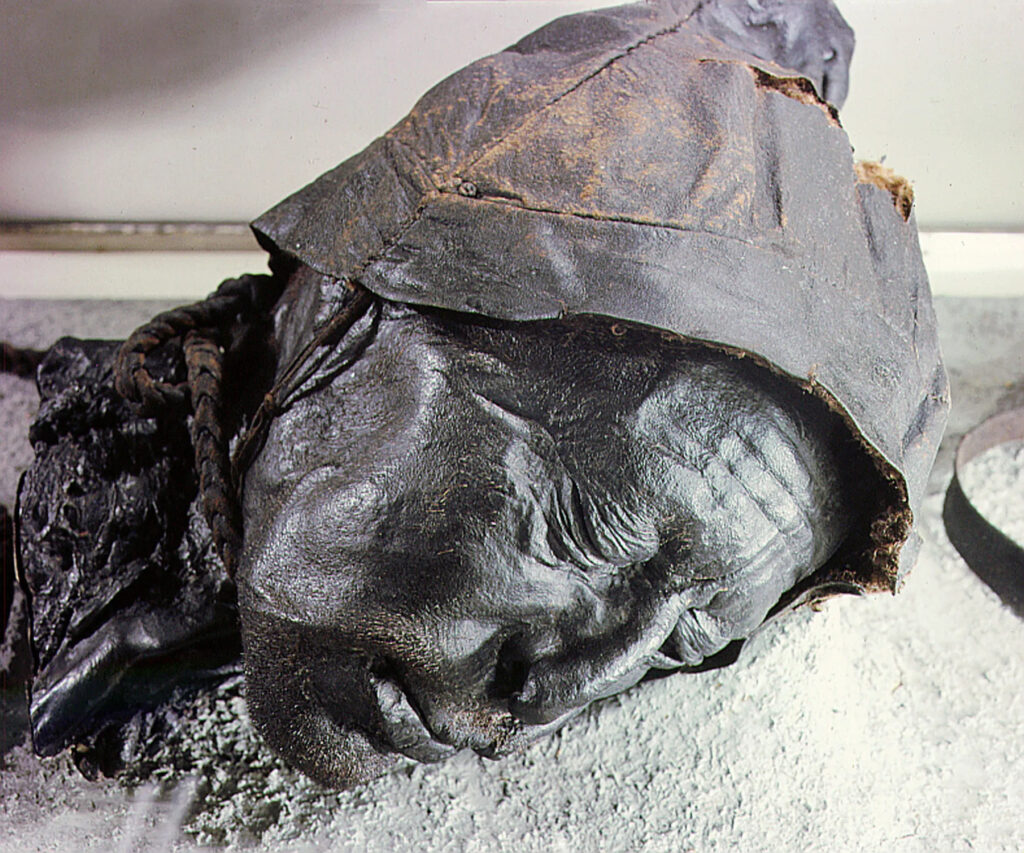
Just When You Thought It Couldn’t Be More Haunting
However, what makes his story even more haunting is that we have no idea who he actually was. No name, no confirmed social status, no record of his life before that final walk to the bog.
Was he a nobleman who volunteered for the ultimate sacrifice? A commoner chosen by lot? A priest or shaman who knew his role from birth?
Think of the human devastation: somewhere, a wife waited for a husband who would never return home. Children wondered why their father didn’t come back from what they thought was just another day. Friends and family knew exactly where he lay in that cold bog water, knew he was dead, and yet couldn’t—or wouldn’t—retrieve his body for proper burial.
The Bog Had A Stench So Strong It Would Have Travelled For Miles
The bog itself would have reeked with the distinctive stench of hydrogen sulphide—that rotten egg smell of swampland—mixed with the acidic, vinegary odour of the preservation process. When the wind changed direction, that death-smell would have wafted over the people’s settlement, a constant smelly reminder of the bodies feeding the bog below. Even a gust of wind would have carried this stench home.
The Sadness
Behind the archaeological fascination lies a profound human tragedy: this preserved specimen was once a child who played and laughed. He was once someone’s best friend, a man with dreams and ambitions, someone who perhaps fell in love and maybe even held his own children. Or maybe he was a single man with plans. He had favourite foods, inside jokes, and hopes for tomorrow. Yet all of that—every memory, every relationship, every moment of joy—was sacrificed to feed the hunger of ancient gods whose names we don’t even remember.
The complete erasure of his identity transforms him into something far more unsettling. This anonymous everyman could have been anyone. And he wasn’t alone in that bog. Twelve years before his discovery, Elling Woman was found in the same marsh. Across Denmark, bog after bog has yielded similar victims: Grauballe Man, Huldremose Woman, and dozens of others. This was systematic ritual murder on a scale that suggests an entire society built around human sacrifice.
The Mystery That Won’t Die
Perhaps most disturbing is how the Tollund Man challenges our assumptions about ancient peoples. This wasn’t a savage, primitive killing—it was sophisticated, planned, and carried out with what appears to be compassion. His peaceful expression suggests he may have been sedated or had accepted his fate.
The bog has preserved him so perfectly that he seems to exist between life and death, a figure both ancient and modern. When visitors see him today at the Silkeborg Museum, many report feeling unsettled—as if those closed eyes might suddenly open, as if he might speak and tell us why he had to die.
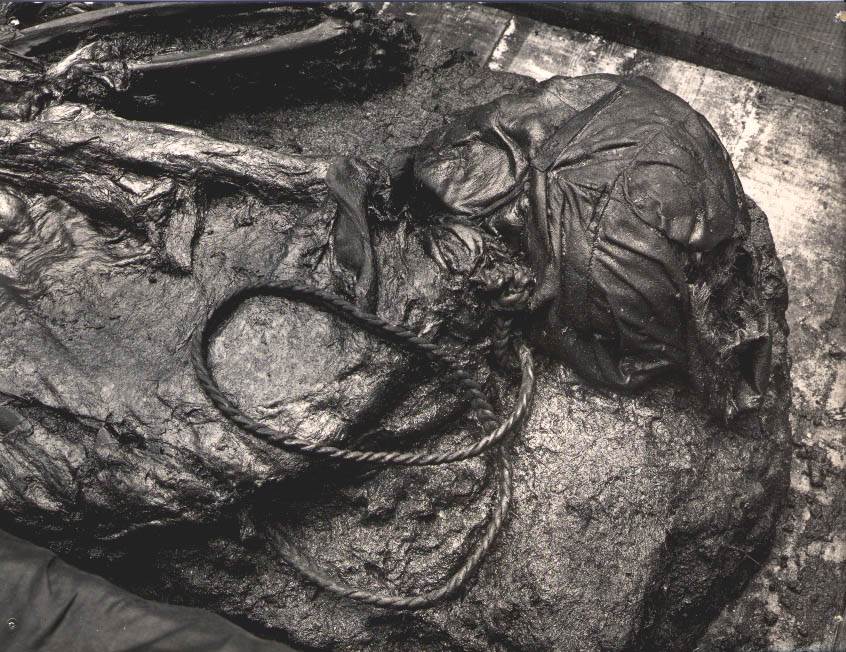
One of Archaeology’s Greatest Horror Stories
The Tollund Man represents one of archaeology’s greatest horror stories. Because it is a true story. In his perfectly preserved face, we see not just an ancient victim, but a mirror reflecting our own capacity for both ritualistic violence and tender care. Has society changed this much, or do these drives still exist today?
He remains suspended between worlds—too well-preserved to feel truly ancient, too ancient to feel truly alive. A man murdered 2,400 years ago who looks like he could have died yesterday, forever carrying the secrets of why someone decided his life must end, and why he seemingly allowed it to happen.
The peat bog gave up its victim, but it has never given up its secrets. And perhaps that’s the most terrifying part of all.
The Horror That Endures
Today, visitors to the Silkeborg Museum stand face-to-face with the Tollund Man in his climate-controlled case, and something profound happens. Children who came expecting to see ancient bones instead encounter a face so lifelike they instinctively step backwards. Adults find themselves whispering in his presence, as if he might be able to hear them.
In Death, His Expression Changes
Some people report that when they see the Tollund man in his casing, they feel sadness for him and empathy. They report not understanding how he died, but felt it was all for nothing. Which, on its own, brings a certain sadness. They also feel as though he could wake at any moment. Still, the most eerie reports are that when viewed from different angles, the peaceful face sometimes changes expression to hint at accusation. A feeling of ‘Why me?’.
Perhaps this is the Tollund Man’s final, terrible gift to us: proof that some horrors are too profound to be buried by time. In preserving his body, the bog also preserved the weight of what was done to him—and what we, as humans, are capable of doing to each other in the name of beliefs we hold sacred.
The Bog Remains Silent
He remains suspended between worlds, forever asking questions we’re not sure we want answered: What would you sacrifice? What would you accept? When the community demands the ultimate price, would you, like him, walk calmly into that waiting darkness?
The bog gave up its victim, but the victim will never give up his secrets—or his silent, eternal judgment of us all.
The Tollund Man can be viewed at the Silkeborg Museum in Denmark, where his unnervingly lifelike remains continue to fascinate and disturb visitors from around the world.

